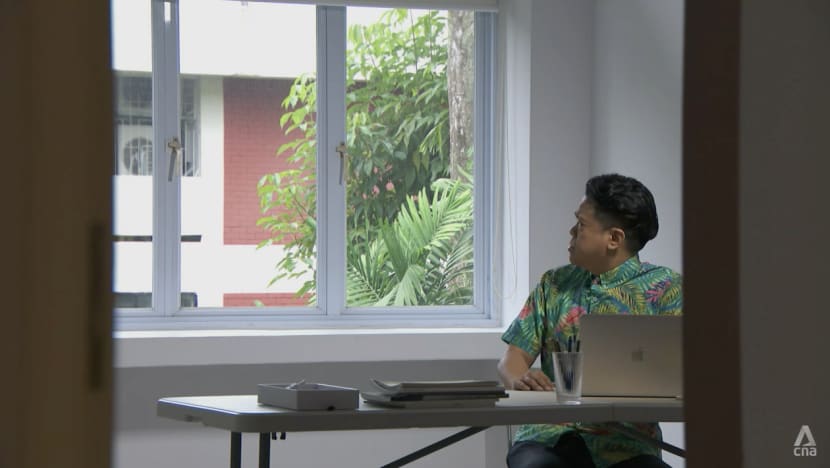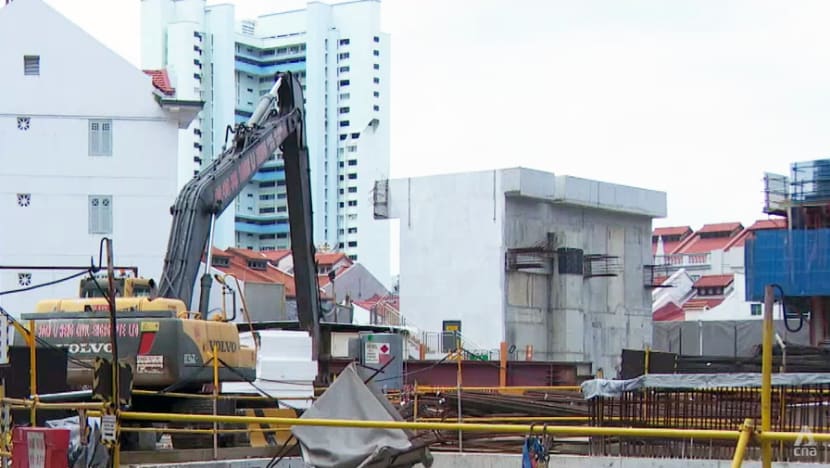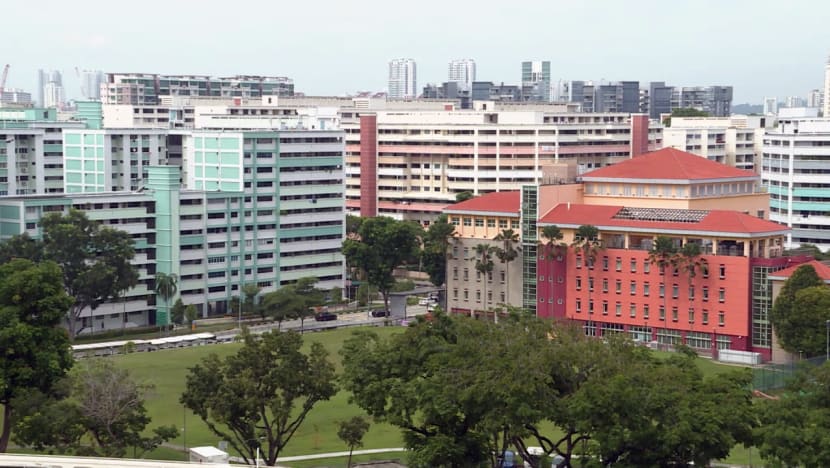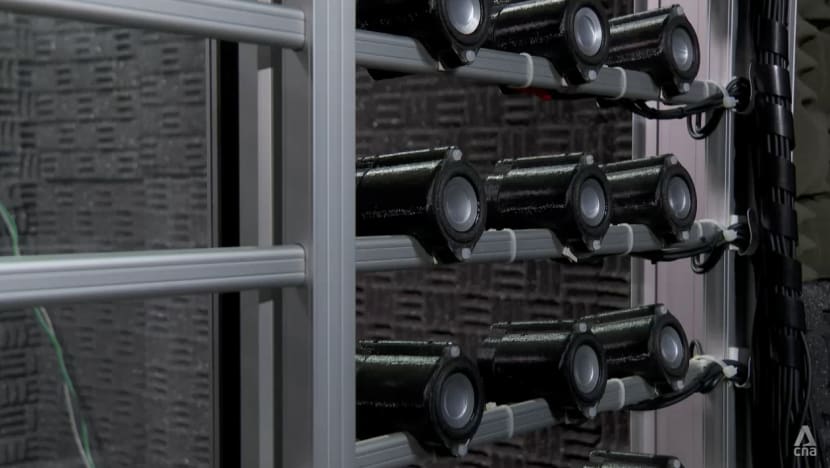Too much noise can harm your health. That’s potentially a problem in Singapore
Plagued by noise? Not only the neighbours but also the outdoor sound levels in Singapore may be problematic. The programme Talking Point explores the implications for health — some unexpected — and how we can deal with the issue.

Are you sick of the noise you must deal with while working from home?
SINGAPORE: For months, Wayne Chan has been putting up with renovation noise coming from neighbouring units.
The full-time emcee, who has had to host events virtually from home during the pandemic, was so annoyed he posted a video on Facebook, complaining about the noise.
Besides drilling, he cited hacking and hammering sounds and things being dragged around.
“This (means) I can’t do these shows as well as I’d like to,” he said. “I always … worry that when I’m in the middle of hosting, drilling is suddenly going to happen.”
He is not alone in finding noise levels a problem. The Housing and Development Board (HDB) received about 11,400 noise-related complaints between January and September last year, a threefold increase compared to the same period in 2019.

Noise from neighbours, however, is not the only thing plaguing Singaporeans. The programme Talking Point explores the different types of environmental noise, how some neighbourhoods are worse off than others, and the impact on health — in ways people least expect.
There are also ways to block out noise, instead of suffering in silence.
WHERE NOISE CAN IRK THE MOST
Most of the noise-related complaints people make tend to be about furniture being dragged in the unit upstairs, the sound of running feet, the playing of loud music or musical instruments and renovation noise.
That is according to Lim Lan Yuan, principal master mediator at the Law Ministry’s Community Mediation Centre (CMC), who helps mediate neighbour dispute cases registered at the CMC.
And with many people still working from home, he does not expect a drop in the number of noise-related cases. “When there are more activities (at home), they’re bound to generate more noise that could affect your neighbours,” he said.
Renovation work like drilling and demolition can produce noise levels above 100 decibels at any given time.
By comparison, the National Environment Agency’s (NEA’s) noise limit for construction work is 90 decibels, measured as an average over five minutes at residential buildings less than 150 metres from the construction site.
Outdoor noise levels around Singapore can also be higher than the prescribed limit.

A 2017 study conducted by National University of Singapore (NUS) researchers found that the average outdoor sound level measured throughout the day was 69.4 decibels, compared to the NEA’s recommended limit of 67 decibels averaged over an hour.
Over 10 weeks, the team took more than 18,700 audio readings across the country, with the help of 52 volunteers who went about their day while using calibrated iPhones.
The noisiest neighbourhoods were Serangoon (73.1 decibels), Orchard and Outram (both 72.8 decibels) and Bukit Timah (72.6 decibels).
Residential areas higher on the list comprised mainly mature estates, like Clementi, Kallang and Rochor, as these have a higher road density than other areas.
WATCH: Top 4 noisiest neighbourhoods in Singapore (3:00)
There were also differences between Singapore’s five regions: On average, the north and west regions recorded lower daytime noise levels compared to the other regions.
The road density is lower in these two regions. The north region also encompasses the Central Water Catchment area and agricultural and industrial zones — generally less populated than residential zones — while the west region includes a heavy industrial zone.
One of the researchers, senior audiologist Diong Huey Ting from Ng Teng Fong General Hospital, told Talking Point that the way an estate is designed, such as where the buildings and overhead bridges are placed, contributes to the acoustic environment.
Enclosed spaces can be worse. “When we have an enclosed area, it traps the sound,” she said. Sound would otherwise dissipate in an open area.

As to whether flats on the upper floors are less affected by noise than residents living below, she noted that while those flats may be physically further from traffic and construction, they could still be exposed to renovation noise.
There are also fewer physical barriers higher up a building to block sounds.
HOW NOISE CAN AFFECT US PHYSICALLY
When it comes to renovation noise, not much can be done either. Chan, who complained to his condominium management besides posting on social media, found that out as no one was breaking the rules.
The HDB guidelines, which also apply to condominiums, classify renovation into two types: General and noisy.
Noisy renovation, like drilling and demolition work, can be carried out only between 9am and 5pm on weekdays; general renovation, which includes carpentry work and painting, can go on until 6pm on weekdays and Saturdays.

Renovation is not allowed on Sundays and public holidays.
Chan said, however, that just having to deal with the noise has affected him physically.
“(It) makes you a little bit more … tense. And all of that would result in you not resting as well as you’d like to,” he said. “I feel pretty trapped in my own house.”
Indeed, noise can have a real impact on one’s health, according to William Hal Martin, the director of NUS’ graduate studies in audiology who led the 2017 research, Singapore’s biggest study of environmental noise and the health implications.
The professor said prolonged exposure to city noise, like from aeroplanes, construction and diesel buses, is associated with long-term health problems such as general stress, insomnia and even cardiovascular disease.

This is why, noted Diong, the World Health Organisation’s guideline for community noise in outdoor living areas, for example, is a limit of 55 decibels averaged out over the daytime and evening.
In a paper published this year, the researchers said their study therefore suggests the Singapore population “is potentially at risk of adverse non-auditory health effects”, referring to non-ear-related issues.
Related article:
These include metabolic effects, cognitive impairment and mental health impacts in the long term. The risk of hypertension may also increase.
Another kind of noise that can pose a danger is sound loud enough to cause physical damage to the inner ear, for example from loud music at places like nightclubs or even dance studios.

“It’s a combination of how high the volume is and how long you hear it that causes the damage,” said Martin.
In the inner ear, a structure called the cochlear has thousands of hair cells — as many as 18,000 in a young, healthy ear, he noted. Loud noise damages these cells, which do not regenerate, and may cause permanent hearing loss.
TAKE HEED, AND FIGHT NOISE WITH NOISE
There are ways, however, to spot the warning signs of hearing loss.
“The first people who are probably going to notice are going to be your friends and family, because you’ll be saying, ‘Huh, what?’ (and) missing a lot,” said Martin. “Another (sign) is something we call tinnitus — ringing in the ears.”
WATCH: The full episode — Noisy Singapore? How noise pollution is affecting us (23:09)
Tinnitus is often a sign of damage to the inner ear. And a hearing test is advised, he added.
But besides thinking twice about pumping up the volume, what are some ways to deal with the noise around us that we cannot control?
One novel solution being developed by Nanyang Technological University researchers is a prototype called an Anti-Noise Control Window, which promises to cut noise levels by at least 10 decibels.
Microphones installed in small speakers on the window can pick up outside noise and reduce it by generating opposite sound waves.

But the team still faces two main challenges: The speakers obstruct the view from the window, and they need to be a lot bigger to reduce noise in a space like an apartment.
Lam Bhan, the assistant professor who developed the prototype along with other researchers, said the window is a “proof-of-principle prototype” and that they hope to solve the challenges within five to 10 years.
In the meantime, there are alternative methods of dealing with noise pollution, as suggested by Ng Teng Fong General Hospital’s head of audiology, Gary Lee.
He said sound can be used therapeutically to create “a sense of peace”, lower stress and even “evoke good memories”. Hence a white noise app playing pleasant sounds in the background, like the sounds of water or nature, can help.

“You set it at a level that isn’t too loud — it doesn’t need to mask the annoying sounds. But it kind of fills the noise floor, and then subconsciously, it’d evoke pleasant feelings,” said the doctor.
Air purifiers that emit neutral background noise can also help to “reduce the distinction between the noise floor and other trigger sounds that perhaps you have in your neighbourhood”.
There is even a sound pillow, with a little speaker inside, that can be connected to a phone or compact disc player.
“There are a lot of tools to help people make their homes filled with pleasant and soothing sounds,” said Lee.
Watch this episode of Talking Point here. The programme airs on Channel 5 every Thursday at 9.30pm.
Editor’s note: This story has been edited to clarify that CMC mediator Lim Lan Yuan does not work with the HDB to mediate cases.

















